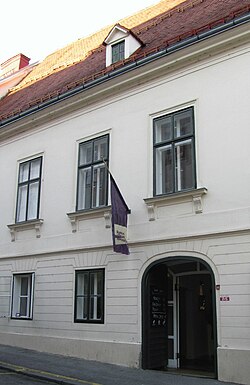
Zagreb is the capital and largest city of Croatia. It is in the north of the country, along the Sava river, at the southern slopes of the Medvednica mountain. Zagreb stands near the international border between Croatia and Slovenia at an elevation of approximately 158 m (518 ft) above sea level. At the 2021 census, the city itself had a population of 767,131, while the population of Zagreb urban agglomeration is slightly above one million people.

Dražen Petrović was a Yugoslav and Croatian professional basketball player. A shooting guard, he initially achieved success playing professional basketball in Europe in the 1980s with Cibona and Real Madrid before joining the National Basketball Association (NBA) in 1989.

Krapina is a town in northern Croatia and the administrative centre of Krapina-Zagorje County with a population of 4,482 (2011) and a total municipality population of 12,480 (2011). Krapina is located in the hilly Zagorje region of Croatia, approximately 55 km (34 mi) away from both Zagreb and Varaždin.
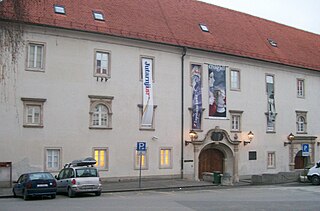
Klovićevi Dvori Gallery is an art gallery in Zagreb, Croatia. Opened in 1982, the gallery is named after the 16th century Croatian-born artist Juraj Julije Klović, considered to be one of the greatest manuscript illuminators of the Italian Renaissance.

The Museum of Contemporary Art is a contemporary art museum located on Dubrovnik Avenue in Zagreb, Croatia. It is the biggest and most modern museum in the country. Vesna Meštrić is current director of MSU, replacing Zdenka Badovinac in late 2023 first temporarily and as of 2024 officially.

Zagreb City Museum or Museum of the City of Zagreb located in 20 Opatička Street, was established in 1907 by the Association of the Brethren of the Croatian Dragon.
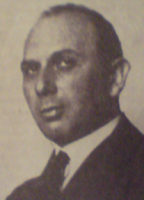
Oskar Herman (1886–1974) was a Croatian-Jewish painter. He was one of the group of Croatian artists known as the Munich Circle, who had a strong influence on modern art in Croatia.

Modern Gallery is a museum in Zagreb, Croatia that holds the most important and comprehensive collection of paintings, sculptures and drawings by 19th and 20th century Croatian artists. The collection numbers around 10,000 works of art, housed since 1934 in the historic Vranyczany Palace in the centre of Zagreb, overlooking the Zrinjevac Park. A secondary gallery is the Josip Račić Studio at Margaretska 3.

The Marton Museum is Croatia's first private museum and specializes in 18th and 19th century European applied art. The Marton Museum derives its name from its original founder, Veljko Marton, whose collection is featured within its walls.

The Croatian Museum of Naïve Art is a fine art museum in Zagreb, Croatia dedicated to the work of naïve artists of the 20th century. The museum holdings consist of over 1,900 works of art - paintings, sculptures, drawings and prints, mainly by Croatians but also by other well-known international artists in the genre.

The Nikola Tesla Technical Museum is a technology museum located in Zagreb, Croatia, which collects and showcases scientific and technical appliances used in the country's history. It exhibits numerous historic aircraft, cars, machinery and equipment.

The Archaeological Museum in Zagreb, Croatia is an archaeological museum with over 450,000 varied artifacts and monuments, gathered from various sources but mostly from Croatia and in particular from the surroundings of Zagreb.

Salamon Berger Ouz was a Croatian Jewish industrialist, textile trader, and founder and first director of the Ethnographic Museum in Zagreb.

The Museum of Arts and Crafts in Zagreb, Croatia, was established in 1880, by the initiative of the Arts Society and its former President Izidor Kršnjavi. Drawing on the theoretical precepts of England's Arts and Crafts movement and the intellectual postulates of Gottfried Semper, the museum was devised with the aim of creating a collection of models for master craftsmen and artist to reinvigorate the production of everyday use items. The strategy of the museum's activity was focused on preservation of traditional crafts, as well as creation of a new middle class aesthetic culture. Therefore, in 1882 the Crafts School was founded along the museum. The building, constructed in 1888 by Hermann Bollé, is one of the first purpose-built edifices devised to merge the functions of the museum and the school. Stylistically, the building is a grand historicist palace in the spirit of the German Renaissance.

Museum of Serbs of Croatia was a public museum in Zagreb, which was specialized in history of Serbs of Croatia. Museum existed from 1946 till 1963 when it became part of Croatian History Museum. Today, part of the material is kept in Museum of Metropolitanate of Zagreb and Ljubljana, part in Prosvjeta, some in Museum of Croatian History and part of them were destroyed in mining of Museum of Metropolitanate of Zagreb and Ljubljana on 11 April 1992 during War in Croatia. In 2009, on 65 anniversary of Prosvjeta, organization has launched an initiative for restoration of museum work.
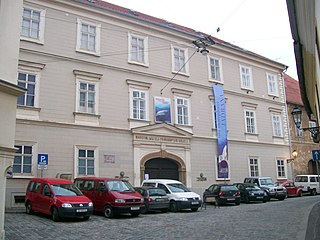
The Croatian Natural History Museum is the oldest and biggest natural history museum and the main body for natural history research, preservation and collection in Croatia. Located on Dimitrije Demeter Street in Gornji Grad, one of the oldest neighbourhoods of the Croatian capital Zagreb, it owns one of the biggest museum collections in Croatia, with over 2 million artefacts, including over 1.1 million animal specimens. It was founded in 1846 as the "National Museum". The National Museum was later split up into five museums, three of which were in 1986 merged as departments of the newly named Croatian Natural History Museum. The museum contains a large scientific library open to the public, and publishes the first Croatian natural history scientific journal, Natura Croatica.

Croatian History Museum is a museum of history located in the Vojković Palace on Antun Gustav Matoš Street in the historic Gornji Grad district of Zagreb, Croatia. The museum holdings consist of around 300,000 objects divided into 17 collections. In addition to a part of the Meštrović Pavilion, it also administers the Ivan Goran Kovačić Memorial Museum in Lukovdol.

The War Childhood Museum is a historical museum in Sarajevo, Bosnia-Herzegovina that opened in January 2017. The museum presents the experiences of children who lived through the war in Bosnia, told through objects, video testimonies, and excerpts from oral histories. The 2018 Council of Europe Museum Prize, one of the most prestigious awards in the museum industry, was awarded to the War Childhood Museum as part of the 2018 European Museum of the Year Award.

The International Banana Museum was a museum located in Mecca, California, dedicated to the banana. The one-room museum contains more than 20,000 items related to bananas. In 1999, the museum set a Guinness World Record as the largest museum devoted to a single fruit. Due to the COVID-19 pandemic, the museum stated it would close. As of August 2023, it remained closed.
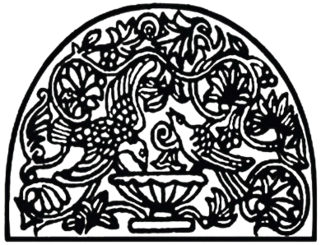
Museum of Literature and Theater Arts of Bosnia and Herzegovina is a literary art museum in Sarajevo, Bosnia and Herzegovina. It was established under the name Museum of Literature of Bosnia and Herzegovina in 1961 on the idea of then curator of literary collections in the Museum of Sarajevo, writer Razija Handžić, the future director. In 1970, the Theater Department was founded and added to the Museum of Literature.
